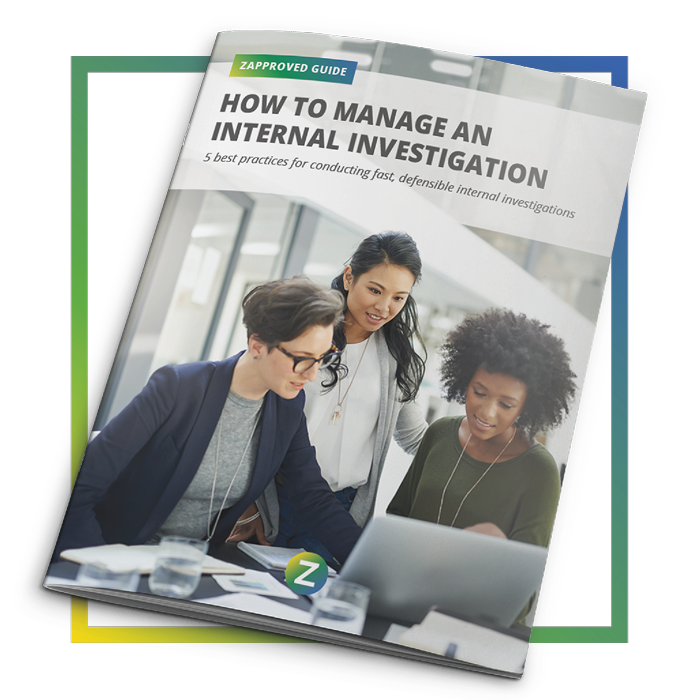Internal Investigations
Conducting Fast, Defensible Internal Investigations
Internal investigations can be daunting for any legal team. The matters are often highly sensitive, time is critical, and there is no room for error.

What are Internal Investigations?
In its most basic sense, an internal investigation is an inquiry into a company or organization’s internal affairs and operations.
Internal investigations or ediscovery investigations are conducted in response to allegations of wrongdoing or violations of regulatory compliance within a company or organization. The allegation(s) can be made informally (for example, employees reporting misconduct to their supervisor) or formally (through threatened or active litigation naming the company and/or its employees in a lawsuit). Internal investigations can also be conducted in response to findings of violations from regulatory bodies (such as the U.S. Security and Exchange Commission or the U.S. Food and Drug Administration) or as part of a due diligence process before a merger or acquisition.
The purpose of internal investigations is to determine whether or not any wrongdoing occurred within a company. The result of the investigation is supposed to answer the question: Is the company at fault?
While some companies tend to see more internal investigations than others due to the industry they exist in, all companies and organizations are affected.

Why Are Internal Investigations Important?
Internal investigations are important for three main reasons:
1) The information discovered during an internal investigation will help the company determine its next steps in responding to the allegation.
- If a company finds evidence that it and/or its employees are at fault, the company will often want to avoid a lawsuit and will most likely try to settle out of court or compensate for damages. On the other hand, if a company conducts a thorough internal investigation and can find no evidence to substantiate the investigative claim, the company may choose to fight the allegations.
- Corporate legal teams need to establish a complete view of the evidence in order to make sound decisions on how to proceed with the matter. Failure to conduct effective investigations leaves legal teams vulnerable to being blindsided in court by evidence left undiscovered.
- Additionally, poorly conducted internal investigations can lead to a misallocation of internal and external resources to fight or settle a matter.
2) Regular internal investigations can reduce legal risk by helping companies address potential issues before they develop into greater problems.
- In highly regulated industries (such as banking, utilities, pharmaceuticals, etc.), reports of compliance violations are fairly common and are usually accompanied by additional opportunities to prove compliance. If, through a detailed internal investigation, a company determined which actions led to the compliance violation, the company can correct behavior or processes before committing a second or third violation for the same practice.
- Many internal investigations revolve around employment matters such as accusations of wrongful termination, sexual harassment, and Equal Employment Opportunity Commission (EEOC) violations. Internal investigations can reveal if companies have a systemic problem in their employment practices. Making changes based on findings from internal investigations can mitigate risk and prevent future lawsuits from happening.
3. Failure to conduct thorough and sincere internal investigations can negatively impact the way a company is viewed both by the public/media, and by presiding legal bodies.
- Repeated violations, findings of wrongdoing, and accusations of incomplete internal investigations can label a company as irresponsible, reckless, and mismanaged.
- If a company has this history and reputation, and has proven to not use internal investigations properly as a tool to prevent the violations from happening, a judge or regulatory body will most likely assign harsher punishments and fines. Those are very real risks most companies can’t afford.
- Failure to prove a comprehensive and prompt internal investigation was conducted is especially harmful to a company’s reputation and pocketbook when it involves employment matters. The ten largest EEOC settlements range from $54M to $250M (https://www.hcamag.com/us/news/general/10-of-the-biggest-eeoc-settlements-ever/156010).
ZDiscovery for Internal Investigations

What Happens During an Internal Investigation?
The actual act of conducting an internal investigation varies by the subject matter of the allegation. But a basic internal investigation process involves the preservation, collection, and review of company-held data that is relevant to the investigative matter. This can include, but is not limited to, employee emails and text messages, work product saved on company and personal drives, company financial statements, employee records, etc. In addition to data collection and review, the investigating team may also choose to interview employees.
Effective internal investigations are usually a joint effort between legal/ediscovery, and data management/IT teams. The legal/ediscovery teams first determine the scope of the investigation (timeframes, employees involved, potentially relevant data sources), and the data management teams preserve and collect the data set forth in the scope, and then send the data back to the legal/ediscovery team to be reviewed. Depending on the size and scope of the investigations, along with company resources, in-house teams may choose to hire outside counsel to help with or manage the review and recommend next steps.
The alleged wrongdoing may only impact the company itself and its employees (for example, an investigation into retaliation or embezzlement). Or the alleged wrongdoing may also impact other organizations, industries, and consumers (for example, price manipulation, fraud, or insider trading). Either way, corporate legal teams use internal investigations to inform their decision making about the allegation or active litigation case.
After the evidence is collected and reviewed, legal teams will determine how to proceed based on the findings of the investigation.
Choosing the Right Ediscovery Software for Internal Investigations
Internal investigations require rapid and thorough responses, which simply can’t be achieved with a manual process or outsourced service provider. Ediscovery software can be leveraged to create a streamlined, repeatable, and comprehensive investigation process.
Look for a system that helps you uncover the facts faster, reduce risks and costs, and is easy to use.
- Legal hold templates, notifications, reminders, escalations, and custodian tracking.
- Silent custodian holds for sensitive matters.
- Built-in data processing with automated deduplication and deNISTing.
- Document review tools with intuitive search filters and email conversation views.
- Redact sensitive data in seconds.
- No extensive system training or certifications needed: equip the entire legal team and other stakeholders (like HR) with an easy to use system.
Additional Reading

How to Manage an Internal Investigation
If you’re prepared to respond to the threat of litigation through a robust ediscovery practice, you’ll be well-positioned to respond to a regulatory inquiry. This 7-step guide to regulatory response can help.

Making the Case for In-House Ediscovery
A practical guide to help legal professionals successfully advocate within their organization and build a business case for in-house preservation, processing, culling, and review software.

